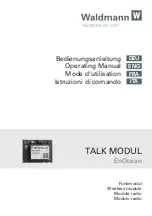
Chengdu Ebyte Electronic Technology Co.,Ltd.
E31-433T17D1B User Manual
Copyright ©2012–2021
,
Chengdu Ebyte Electronic Technology Co.,Ltd.
12
Transmitting
The module receives the users’ data of serial port, and transmit 58 bytes wireless data packet. When the
input data packet reaches 58 bytes, the module will start the wireless transmission, thus users can
continue to input the transmitting data; When the input data packet is less than 58 bytes, the module will
wait 3 bytes time, if there’s no more data packet input, it means the data input finished, so the module
will send all data packet out via wireless; After the module receives the first data packet, the AUX
outputs low level; When module put all data into RF chip and start the transmission, the AUX outputs
high level; At this time, it means the last data packet starts wireless transmission, users can continue to
input 512 bytes data at most; The data packet sent in Mode 0 can be only received by the module with
Mode 0 and Mode 1.
Receiving
The module always open the wireless receiving function on, then it can receive the data packet sent by
Mode 0 and Mode 1.
After receiving the data packet, the AUX of module outputs low level and after delaying 5ms, the
wireless data will be transmitted via TXD pins of serial port. After all wireless data is transmitted via
serial port, the AUX outputs high level.
6.3 WOR mode
(
Mode 1
)
Type
When M0 = 1
,
M1 = 0
,
the module works on Mode 1
Transmitting
The condition of module starting data packet transmission and the AUX function equal to Mode 0. The
only difference is that module will add wake-up code automatically before each data packet. The length
of wake-up code depends on the wake-up time set by users, the purpose of wake-up code is to wake up
the module with Mode 2; So, the transmitting data in Mode 1 can be received by the module with Mode
0, 1, 2.
Receiving
It equals to Mode 0.
6.4 Power saving mode
(
Mode 2
)
Type
When M0 = 0
,
M1 = 1
,
the module works on Mode 2
Transmitting
The module is on sleep mode, serial port is close, so it cannot receive the serial port data of external
MCU. Thus, this module does not feature wireless transmitting function.
Receiving
In mode 2, the transmitter must be work in Mode 1; Monitoring the wake-up code at regular time, once a
valid wake-up code is received, the module continue to receive and wait for the entire valid data packet
to be received; Then AUX outputs low level, after delaying 5ms, the serial port is open and the received
wireless data will be transmitted via TXD, after that, AUX outputs high level; Wireless module continue
to enter “Sleep-Monitor”working mode(polling); Set different wake-up time, the module has different
receiving response time (max 2s) and different average power consumption(min 30uA); Users need to
strike a balance between communication latency and average power consumption.
6.5 Sleep mode
(
Mode 3
)
Type
When M0 = 1
,
M1 = 1
,
the module works on Mode 3
Transmitting
Transmitting the wireless data is unavailable.
Receiving
Receiving the wireless data is unavailable.
Configuration
Sleep mode can be used for module parameter setting. Use serial port 9600, 8N1 to set module working
parameters via specific command format.
Note
When entering other modes from the sleep mode, the module will reconfigure the parameters. During the
configuration process, AUX keeps low level; after that, AUX outputs high level, so it is recommended that the
user detect the AUX rising edge.







































